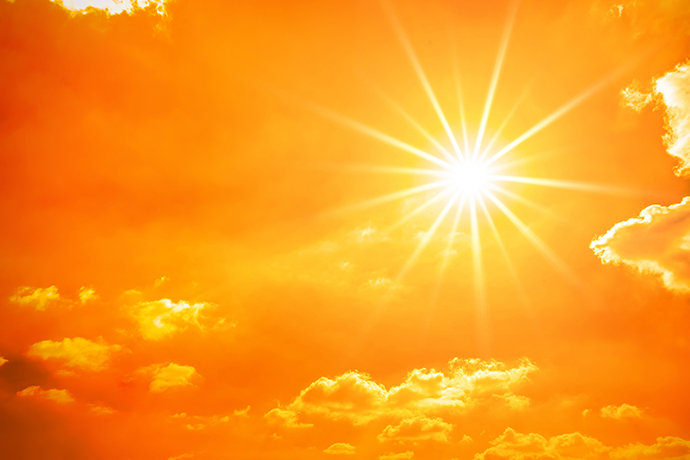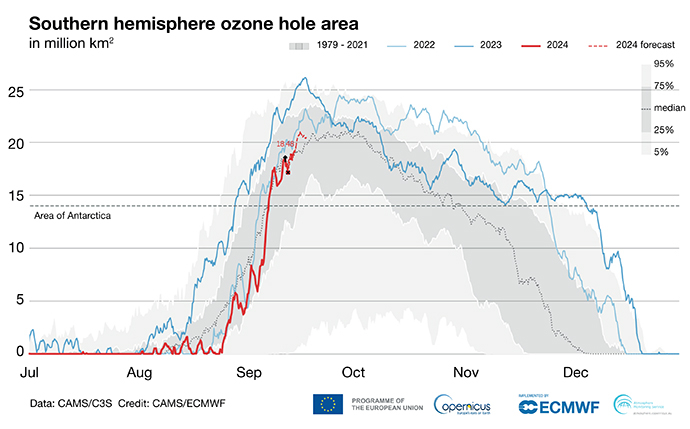

Image: © Xurzon/iStock/Getty Images Plus
In 1994, the United Nations General Assembly proclaimed 16 September as the International Day for the Preservation of the Ozone Layer, commemorating the date of the signing, in 1987, of the Montreal Protocol on Substances that Deplete the Ozone Layer.
In the 1970s and 80s, it was recognised that a number of commonly used man-made chemicals containing halogens, such as chlorine, bromine and fluorine, were causing serious damage to the stratospheric ozone layer. The dangers that this represented, and the extent of the damage caused, were recognised universally and resulted in the historic agreement to phase out the production and use of the ozone-depleting substances responsible.
About 90% of ozone is concentrated in the stratosphere between 15 and 30 km, where it plays a crucial role in protecting us and other life on Earth from harmful ultraviolet (UV) radiation.
Ozone-depleting substances (ODS) have caused damage to the stratospheric ozone layer worldwide, but the effects are most significant over the Antarctic region in late winter and early spring (August to November). This loss of Antarctic ozone has come to be known as the ozone hole. Significant depletion of stratospheric ozone has also occurred in the northern hemisphere winter over the Arctic region in recent decades.
The Montreal Protocol has been very successful in controlling the production and use of ODS, and their abundance in the atmosphere is generally declining. According to UNEP’s assessments, thanks to the efficient implementation of the treaty, the ozone layer is projected to recover by the middle of this century, avoiding a tenfold increase by 2050 compared to the current levels.
The 2024 season has seen a fairly slow start in the development of the ozone hole (see also Figure 1).
A vital role in monitoring ozone
The Copernicus Atmosphere Monitoring Service (CAMS), implemented by ECMWF on behalf of the EU, plays an important role in monitoring, forecasting and understanding the behaviour of ozone in the atmosphere.
CAMS monitors ozone in near-real time and follows the day-to-day development of the ozone hole each year. Daily forecasts are also produced out to five days ahead. CAMS has a dedicated ozone monitoring page, updated daily during the ozone hole season.

Figure 1: The evolution of the Antarctic ozone hole is monitored daily by the Copernicus Atmosphere Monitoring Service in near-real time during the ozone hole season (in southern hemisphere winter). The chart shows the area of the ozone hole in recent years, with the average conditions over the period 1979 to 2021. The CAMS five-day forecast of the ozone hole area is also shown. The ozone hole is defined by total column ozone values below 220 Dobson Unit (DU). One Dobson Unit is the number of molecules of ozone that would be required to create a layer of pure ozone 0.01 millimetres thick at a temperature of 0 degrees Celsius and a pressure of 1 atmosphere.
CAMS data make it possible to look in detail at how ozone varies geographically, its distribution with height and how this varies over time. The modelling of detailed stratospheric chemistry is dynamically coupled to atmospheric circulation, and this makes it possible to investigate the processes at play.
The CAMS/C3S record of ozone (and other aspects of atmospheric composition), which stretches back to 1979, is also vital to assess the evolution of the stratospheric ozone hole over time, and how its recovery progresses thanks to the successful implementation of the Montreal Protocol.
Figure 2 shows another example of ozone-related products from CAMS – the five-day forecast of total column ozone, which is produced daily, along with forecasts of many other atmospheric constituents.
Figure 2: Five-day forecasts of total column ozone are produced daily. This chart is centred on the Antarctic region. Areas coloured yellow, orange and red depict higher ozone values, whereas green and blue areas show lower values. The solid black line is the 220 DU contour, which is commonly used to define the area of the ozone hole.
The CAMS global modelling system is based on ECMWF’s Integrated Forecasting System (IFS), which has been extended to include the simulation of reactive trace gases, aerosols and greenhouse gases. Atmospheric composition is simulated ‘on-line’, so atmospheric chemistry and physical and dynamical processes are closely coupled and consistent with each other.
It also means that the data assimilation capability of the IFS can be used to incorporate a range of observations of atmospheric composition, including ozone levels, from satellites and ground-based instruments. Analysis and forecasts are delivered twice a day, every day with a resolution of approximately 40 km and 137 vertical levels with 1-hourly to 3-hourly temporal resolution (depending on the variable considered).
CAMS also maintains and updates a quality-assured record of ozone levels going back to 2003, and the Copernicus Climate Change Service (C3S) provides an extension back to 1979.
Such records are created by running the modelling system on past years, incorporating available Earth observation data, giving us a 45-year global reanalysis of ozone levels (along with many other aspects of atmospheric composition). Three-hourly and monthly data are available at a horizontal resolution of approximately 80 km and on 60 vertical levels.
Comparing each year’s Antarctic ozone hole with previous years is vital to understand the natural variability of the ozone hole and assess how the ozone layer is responding in light of action taken under the Montreal Protocol (and its subsequent amendments and additions).
Attempts to assimilate measurements of stratospheric ozone at ECMWF began in 1990, using a linear parametrization scheme to describe the chemistry of stratospheric ozone. A major IFS upgrade in 2023 introduced explicit chemical mechanisms to simulate chemistry in the stratosphere – a major step forward.
Today’s atmospheric chemistry scheme means that CAMS can monitor and forecast chemicals in the atmosphere that control the formation of the ozone hole, such as chlorofluorocarbons (CFCs) and hydrochlorofluorocarbons (HCFCs) and their short-lived products that cause the destruction of ozone.
CAMS ozone monitoring products are used by a range of policymakers, including the United Nations Environment Programme scientific assessments of the ozone layer and the World Meteorological Organization’s ozone bulletins.
ECMWF implements CAMS on behalf of the European Union, working with over 50 service providers from 20 different European countries. The service provides information on many other aspects of air quality and atmospheric composition, greenhouse gas fluxes and emissions and their forcing effect on climate, and solar radiation. All CAMS data are open and free of charge and are provided through the Atmosphere Data Store.
